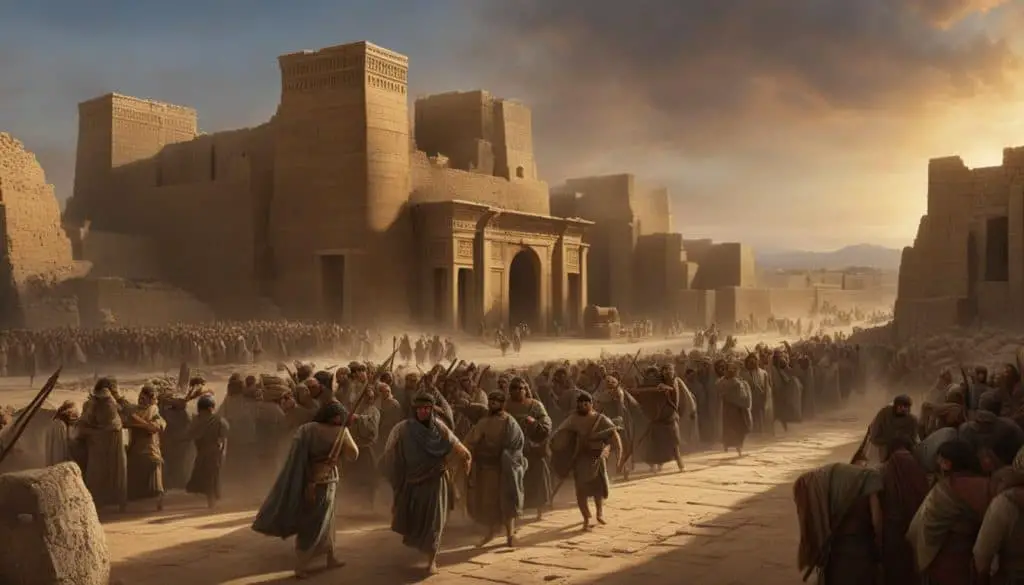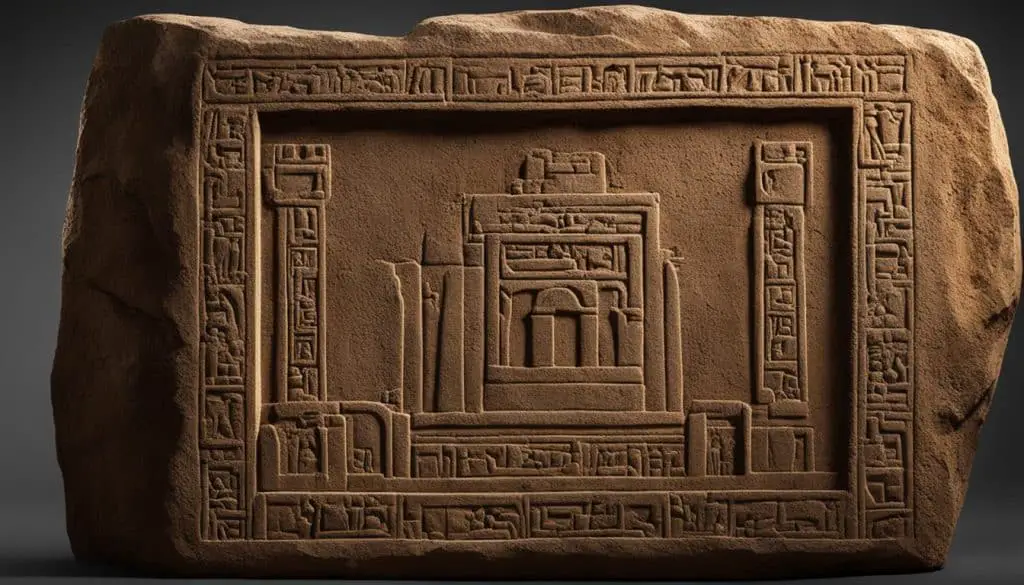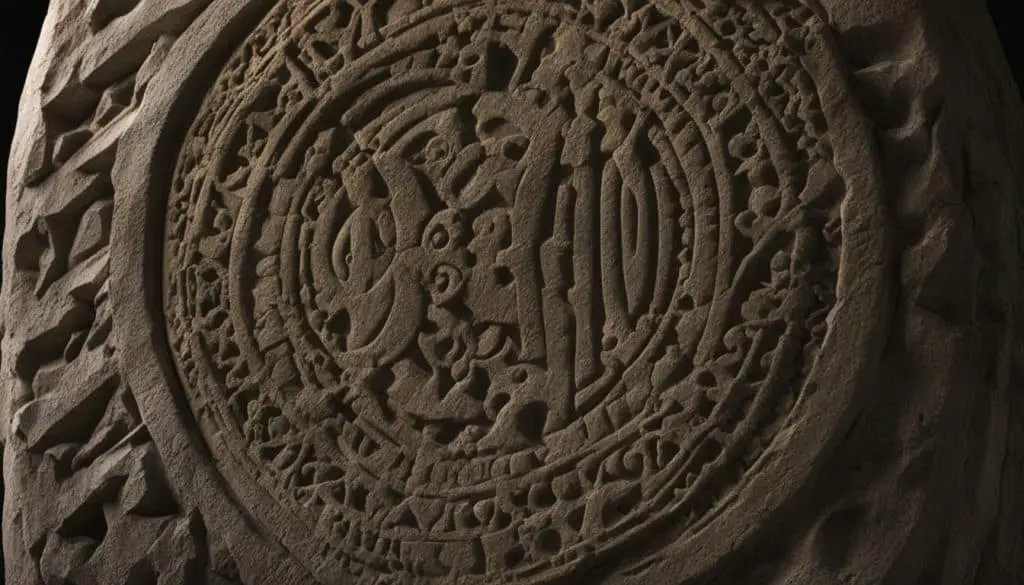Have you ever wondered if the stories in the Bible have any historical truth behind them? Are they mere myths or do they have a basis in reality? Prepare to be amazed as we delve into the world of archaeological findings and ancient records, uncovering 10 compelling examples of historical accuracy in the Bible.
From the existence of the powerful Hittite empire to the confirmed accounts of the Babylonian exile, these discoveries align with biblical accuracy, providing evidence for the Bible’s historical reliability. So, let’s embark on this fascinating journey together and challenge common beliefs as we explore the truth behind the Scriptures.
The Existence of Hittites: Confirmed by Archaeological Discoveries
In the biblical narrative, the Hittites are mentioned in Genesis 15:20 and Joshua 1:4. For centuries, their existence was considered nothing more than a biblical myth. However, archaeological discoveries have provided compelling evidence that the Hittites were a real empire that flourished in the ancient Near East.
The Hittite Empire, located in what is now modern-day Turkey, was a powerful and influential force during the Late Bronze Age. Their capital, Hattusa, boasted impressive fortifications, temples, and a rich culture. The Hittites were skilled in warfare, diplomacy, and trade, and they exerted significant influence over the region.
One of the most remarkable archaeological finds is the Seated Deity of Ḫayasa, a statue believed to represent a Hittite god or goddess. This artifact serves as a tangible link to the Hittite civilization, confirming their existence and dispelling any doubts about their historical reality.
Another notable discovery is the Tell Tayinat Archaeological Project, which unearthed a royal palace and temples that further attest to the grandeur of the Hittite Empire. These findings, along with countless others, provide a wealth of archaeological evidence supporting the existence and significance of the Hittites.
“The archaeological discoveries validate the biblical accounts of the Hittites and emphasize the importance of the ancient Near East as a cradle of civilization.”
The confirmation of the Hittite Empire’s existence not only affirms the historical accuracy of the Bible but also sheds light on the cultural and political landscape of the ancient Near East. It is a testament to the enduring value of archaeological research in uncovering the truths of our past.
The Babylonian Exile: Historical Records Support Biblical Account
The accounts in 2 Kings 24-25 and Jeremiah 52 provide a detailed narrative of the Babylonian conquest of Judah, the destruction of Jerusalem and its temple in 586 BC, and the exile of the Jewish people to Babylon. These biblical records, once regarded by some as mere legends, have been corroborated by historical records and archaeological findings.
Archaeological excavations in Babylon and other ancient Mesopotamian sites have uncovered inscriptions, clay tablets, and other artifacts that confirm the presence of the Jewish exiles and their integration into Babylonian society during the 6th century BC.
One significant archaeological finding is the Cyrus Cylinder, a clay cylinder inscribed with the decree of Cyrus the Great, the Persian king who conquered Babylon. The cylinder records Cyrus’ policy of allowing conquered peoples, including the Jews, to return to their homelands and rebuild their temples.
“I returned to these sacred cities on the other side of the Tigris… I also gathered all their former inhabitants and returned them their habitations.” – Cyrus Cylinder
Additional historical records from Babylonian and Persian sources, such as the Babylonian Chronicles and the Nabonidus Chronicles, provide further documentation of the Babylonian exile and the events surrounding the fall of Jerusalem.
The archaeological evidence, combined with these historical records, verifies the accuracy of the biblical account of the Babylonian exile. It establishes the historical reality of the Jewish people’s captivity in Babylon and their eventual return to their homeland, as described in the books of Ezra and Nehemiah.
Key Events of the Babylonian Exile
| Events | Year |
|---|---|
| Destruction of Jerusalem and the First Temple | 586 BC |
| Exile of the Jewish people to Babylon | 586-538 BC |
| Decree of Cyrus the Great allowing Jews to return | 539 BC |
| Rebuilding of the Second Temple | 516 BC |

Cyrus the Great’s Edict: Historical Confirmation of the Return of Exiled Jews
According to the Bible, Cyrus the Great, the ruler of Persia, issued an edict that allowed the exiled Jews to return to their homeland. This momentous historical event is also documented in the books of Ezra and 2 Chronicles.
Cyrus the Great, known for his benevolent rule and tolerance, conquered Babylon in 539 BC, putting an end to the Babylonian Empire. In an unprecedented act of mercy, he not only allowed the Jews who were exiled from the Kingdom of Judah to return but also supported the rebuilding of their temple in Jerusalem.
“Thus says Cyrus king of Persia: The Lord, the God of heaven, has given me all the kingdoms of the earth, and he has charged me to build him a house at Jerusalem, which is in Judah. Whoever is among you of all his people, may his God be with him, and let him go up to Jerusalem, which is in Judah, and rebuild the house of the Lord, the God of Israel. He is the God who is in Jerusalem.”
– Ezra 1:2-3
This edict by Cyrus the Great had a profound impact on the history of the Jewish people. It not only allowed them to return to their ancestral land but also marked the beginning of the Second Temple period.
Archaeological evidence further supports the existence of Cyrus the Great and his benevolent edict. The famous Cyrus Cylinder, discovered in 1879 in ancient Babylon, contains a declaration by Cyrus regarding his policies towards the various conquered nations, including the Jews. This ancient artifact serves as a tangible testament to the historical accuracy of the Bible.
| Key Points | Supporting Evidence |
|---|---|
| Cyrus the Great’s edict allowed exiled Jews to return | The Bible (Ezra 1:1-4, 2 Chronicles 36:22-23) |
| Cyrus Cylinder | Archaeological artifact confirming Cyrus’ policies, including his decree towards the Jews |
Through the edict of Cyrus the Great, the exiled Jews were able to rebuild their lives and restore their religious practices. This pivotal moment in history highlights the benevolence of Cyrus and the enduring impact of his edict on the Jewish people.
The Reign of King David: Evidence from the Tel Dan Stele
When it comes to the reign of King David, direct archaeological evidence may be limited, but there are intriguing discoveries that provide insight into his historical presence. One such artifact is the Tel Dan Stele, which sheds light on a dynastic lineage or kingdom attributed to David.
The Tel Dan Stele is a stone inscription discovered in northern Israel in the late 20th century. It dates back to the 9th century BCE and contains references to the “house of David.” This reference is significant because it signifies the existence of a ruling dynasty or kingdom associated with David.
The stele, which was originally part of a victory monument, mentions wars and conquests, and one line specifically refers to the “king of Israel” and the “king of the house of David.” While the mention of David in this inscription is brief, it provides archaeological evidence supporting the existence of a historical figure named David and his dynasty.
It is important to note that the Tel Dan Stele is not a direct record of King David’s reign or his specific achievements. However, it does offer corroborative evidence for the biblical accounts of David’s existence and his establishment of a lasting dynasty.
“…King of Israel and the king of the house of David…”
The Tel Dan Stele has been the subject of extensive study and analysis by archaeologists, epigraphers, and biblical scholars. Its discovery and interpretation have sparked scholarly discussions about the historicity of King David and the accuracy of biblical narratives.
While archaeological evidence continues to be sought after to further validate the specifics of King David’s reign, the Tel Dan Stele stands as a significant artifact that bolsters the notion of his historical presence and the existence of a dynastic lineage associated with him.
Key findings from the Tel Dan Stele:
- The Tel Dan Stele is a stone inscription discovered in northern Israel.
- It dates back to the 9th century BCE.
- The stele mentions the “house of David,” providing evidence of a dynasty associated with King David.
- While not a direct record of King David’s reign, the inscription supports the biblical accounts of his existence and his establishment of a lasting dynasty.

Pontius Pilate’s Governorship: Historical Confirmation from the Pilate Stone
The existence of Pontius Pilate as the Roman prefect of Judea during the time of Jesus is supported by historical accounts, including the Pilate Stone found in Caesarea.
Pontius Pilate played a significant role in the trial and crucifixion of Jesus Christ. As the Roman prefect of Judea from 26 to 36 AD, he held a position of authority and governed the region under Roman rule.
The Pilate Stone, an archaeological artifact discovered in Caesarea Maritima, provides tangible evidence of Pilate’s role as the Roman prefect. The stone bears an inscription that reads, “Pontius Pilate, Prefect of Judea.” This inscription confirms the historical accuracy of Pilate’s governorship in Judea during the time of Jesus.
The Pilate Stone is a significant find as it directly connects to biblical events and adds further credibility to the accounts of Jesus’ trial before Pilate.
“Pontius Pilate, Prefect of Judea.”
The discovery of the Pilate Stone is a testament to the meticulous nature of historical documentation and the impact of archaeological findings in validating biblical accounts. It highlights the interconnectedness between history, archaeology, and the Bible.
This concrete evidence regarding Pontius Pilate not only confirms the existence of an influential figure during the time of Jesus but also sheds light on the political and historical context of Judea in the first century.

The Pilate Stone serves as a tangible reminder of the historical accuracy of the Bible and the significant role Pontius Pilate played in the events surrounding Jesus’ crucifixion. Its importance extends beyond mere antiquity, offering a glimpse into the world in which Jesus lived and the political dynamics that shaped his final moments on earth.
The Siege of Lachish: Assyrian Records and Archaeological Evidence
The Bible mentions the Assyrian siege of Lachish during King Hezekiah’s reign, providing historical accounts of this significant event. This biblical narrative is further supported by extensive Assyrian records and compelling archaeological evidence, including the renowned Lachish reliefs.
During the 8th century BC, the Assyrian Empire, under the leadership of King Sennacherib, sought to expand its dominion in the region. The city of Lachish, strategically located in the Kingdom of Judah, became a primary target for the mighty Assyrian forces.
Assyrian records, such as the Taylor Prism and the Annals of Sennacherib, provide detailed descriptions of the siege of Lachish. These documents vividly depict the military tactics employed by the Assyrians, the capture of Lachish, and the subsequent subjugation of the surrounding cities.
Archaeological excavations at the site of Lachish have unearthed remarkable evidence of the Assyrian siege. One of the most notable discoveries is the Lachish reliefs, a series of large-scale wall carvings that depict various scenes from the siege. These reliefs offer invaluable insights into the Assyrian military machinery, siege warfare techniques, and the conquest of Lachish.

The Lachish reliefs, now housed in the British Museum, present a visual narrative of the siege, showcasing scenes of battering rams, ladders, and the defeat of the city’s defenders. These intricate carvings provide a tangible connection to the biblical account, confirming the historical accuracy of the siege of Lachish.
Furthermore, the discovery of Assyrian artifacts, such as military equipment and clay tablets containing administrative records, strengthens the archaeological case for the siege. These findings offer additional corroborative evidence of the Assyrian presence and occupation at the site of Lachish during the time of King Hezekiah.
“The Lachish reliefs and the extensive records of the Assyrian Empire provide compelling evidence for the historical accuracy of the siege of Lachish as described in the Bible. These archaeological discoveries shed light on the power and influence of the Assyrian Empire and its impact on the Kingdom of Judah.”
In conclusion, the siege of Lachish stands as a remarkable example of biblical events supported by a wealth of Assyrian records and compelling archaeological findings. The Lachish reliefs, in particular, offer a gripping visual representation of the siege and serve as invaluable evidence of historical accuracy.
| Assyrian Records and Artifacts | Corroborate the biblical account of the siege of Lachish. |
|---|---|
| Lachish Reliefs | Provide vivid visual documentation of the siege and confirm the historical accuracy of the biblical narrative. |
| Archaeological Discoveries | Unearth compelling evidence of the Assyrian presence and occupation at Lachish during King Hezekiah’s reign. |
The Moabite Stone: Confirmation of Moabite Victories over Israel
In the quest for historical validation of events mentioned in the Bible, the Moabite Stone, also known as the Mesha Stele, stands as a remarkable artifact substantiating the Moabite victories over Israel.
Discovered in the 19th century by a French archaeologist in the ancient land of Moab (now modern-day Jordan), the Moabite Stone dates back to the 9th century BC and offers a valuable perspective from the Moabite King Mesha.
“I am Mesha, son of Chemosh-[…], king of Moab, the Dibonite. My father reigned over Moab for thirty years and I have reigned after my father. And I have constructed this high place for Chemosh in Qerio, a sanctuary of salvation. For he saved me from all the kings, and he helped me against all my enemies. Omri was king of Israel, and he oppressed Moab for many days, for Chemosh was angry with his land.”

The Moabite Stone divulges insights into the historical context of the Moabite-Mesha relationship, shedding light on the struggles between Moab and Israel. It corroborates the biblical narratives that mention Moabite victories, providing an archaeological link to the events described.
Notably, the Moabite Stone mentions King Omri of Israel, affirming the existence of his reign and the political tensions between Moab and Israel during that period. It also portrays Chemosh, the Moabite deity, as the protector of Moab against their enemies.
This significant discovery not only adds credibility to the biblical account of Moabite victories but also enriches our understanding of the political landscape and religious practices of ancient times.
Belshazzar’s Feast and the Fall of Babylon: Historical Confirmation
The account of Belshazzar’s feast and the subsequent fall of Babylon to the Medes and Persians is supported by historical evidence. Belshazzar, known as the co-regent or crown prince of Babylon during Nabonidus’s reign, played a significant role in the events that led to the fall of this mighty empire.
“In that same night Belshazzar the Chaldean king was slain. And Darius the Mede received the kingdom.” (Daniel 5:30-31)
Belshazzar’s feast is described in the Book of Daniel as a lavish and sacrilegious event held in the palace of Babylon. During this feast, Babylon was conquered by the Medes and Persians, marking the end of the Neo-Babylonian Empire.
The fall of Babylon to the Medes and Persians is documented in multiple historical accounts, including the writings of Herodotus and Xenophon. The Cyrus Cylinder, an ancient artifact discovered in modern-day Iraq, also provides valuable insights into the conquest of Babylon by Cyrus the Great.
| Historical Evidence | Description |
|---|---|
| Cyrus Cylinder | The Cyrus Cylinder, a clay cylinder inscribed with the accomplishments of Cyrus the Great, validates the historical account of the fall of Babylon and his benevolent policies towards conquered peoples. |
| Historical Records | Accounts from ancient historians such as Herodotus and Xenophon corroborate the fall of Babylon to the Medes and Persians, as well as the end of Belshazzar’s reign. |
The fall of Babylon marked a significant turning point in the ancient world, leading to the rise of the Persian Empire and the liberation of the Jewish people from exile. This event further highlights the historical accuracy of the biblical accounts.

How Do Biblical Worship Examples Connect to Historical Accuracy in the Bible?
The historical accuracy of the Bible is reinforced by biblical worship examples explained throughout its narratives. By analyzing the specific details of worship practices, scholars can make connections to historical events and archeological findings, providing evidence for the reliability of biblical accounts.
The Rule of King Herod the Great and the Existence of Nazareth
During the ancient Roman period, the reign of King Herod the Great left a lasting impact on the region. Historical records vividly portray Herod as a skilled architect, renowned for his ambitious building projects. His most famous architectural endeavor was the magnificent reconstruction of the Second Temple in Jerusalem, a monumental feat that showcased Herod’s grandeur and ambition.
However, Herod’s rule was also marked by a tragic event—the infamous massacre of the innocents. According to the Gospel of Matthew, Herod ordered the execution of all male infants in Bethlehem, in a desperate attempt to eliminate the newborn Jesus, whom the Magi had identified as the future King of the Jews. This heartbreaking episode serves as an illustration of the lengths Herod was willing to go to protect his throne.
Furthermore, archaeological excavations have shed light on the existence of Nazareth during this time. Nazareth, a small village in Galilee, is widely regarded as the childhood home of Jesus. The discoveries provide tangible evidence supporting the biblical accounts and affirm that Nazareth was a thriving settlement in the Roman period. These findings strengthen the historical context of Jesus’ early life and reinforce the significance of the region in shaping his teachings and beliefs.







